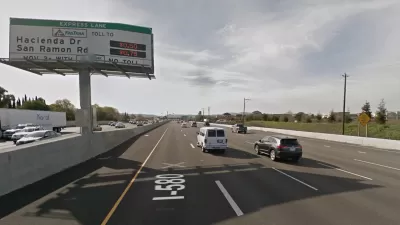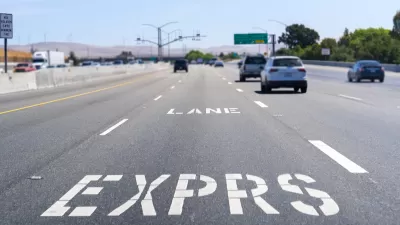A report produced by the county authority that built and operates the I-580 Express Lanes in the Bay Area declares them a success. Operating speeds are faster and congestion is reduced. About 11 percent of the freeway traffic uses the toll lanes.
"The Bay Area’s newest express lanes — on Interstate 580 through the Tri-Valley region of Alameda County — are just a year old, but drivers are already pouring into them, eager to pay for a quicker commute," reports Michael Cabanatuan for the San Francisco Chronicle.
Since the combination express and carpool lanes opened in February 2016 on I-580, along the main route between the Bay Area and the Central Valley, more than 7.6 million drivers have taken advantage of them, according to a report released Thursday [March 16] by the Alameda County Transportation Commission, which operates the lanes.
The report is in the form of a 2-page infographic (pdf) of data compiled by ACTC on the "first year in review," identifying the users:
- Approximately 30,000 trips are taken in the Express Lanes each day
- 6 percent of the corridor’s solo drivers choose to use the Express Lanes as toll-paying customers instead of the general purpose lanes, reducing congestion in the general purpose lanes
- 38 percent of current Express Lane users are using the lanes toll-free.
Tolls
"By paying an average toll of $1.62 westbound and $2.13 eastbound, drivers get to drive about 10 mph faster than those in the other lanes," writes Cabanatuan. Depending on direction, motorists on the express lanes are either paying, on average, roughly the same as a local adult AC Transit fare, $2.10, or 23 percent less.
However, peak hour fares jump to the maximum rate of $9 (see infographic), which will create a problem unless the eastbound "cap" is increased to match the westbound maximum of $13.
As Herbie Huff, research associate at UCLA's Lewis Center for Regional Policy Studies and Institute for Transportation Studies, opined in her recent Los Angeles Times op-ed, dynamic tolling is key to fighting congestion. Since 62 percent of express lane traffic is tolled, increasing the toll is instrumental to keeping traffic moving during the peak hour.
But congestion pricing is not a silver bullet, warns John Goodwin, a spokesman for the Metropolitan Transportation Commission, the Bay Area's metropolitan planning organization.
“I’m not going to tell anyone they will eliminate congestion. They won’t,” said Goodwin of MTC, which is planning the regional network and will operate the new [I-680] lane. “But they will make the roadway operate more efficiently. We will see reduced congestion at the beginning and end of the peak of the commute, but at the peak of the peak, there will still be congestion. It’s not a silver bullet. But it will help.”
Listen to the one-minute KCBS report on the ACTC findings.
FULL STORY: A year later, I-580 pay-to-use lanes are a success, report says

Study: Maui’s Plan to Convert Vacation Rentals to Long-Term Housing Could Cause Nearly $1 Billion Economic Loss
The plan would reduce visitor accommodation by 25,% resulting in 1,900 jobs lost.

Alabama: Trump Terminates Settlements for Black Communities Harmed By Raw Sewage
Trump deemed the landmark civil rights agreement “illegal DEI and environmental justice policy.”

Why Should We Subsidize Public Transportation?
Many public transit agencies face financial stress due to rising costs, declining fare revenue, and declining subsidies. Transit advocates must provide a strong business case for increasing public transit funding.

Paris Bike Boom Leads to Steep Drop in Air Pollution
The French city’s air quality has improved dramatically in the past 20 years, coinciding with a growth in cycling.

Why Housing Costs More to Build in California Than in Texas
Hard costs like labor and materials combined with ‘soft’ costs such as permitting make building in the San Francisco Bay Area almost three times as costly as in Texas cities.

San Diego County Sees a Rise in Urban Coyotes
San Diego County experiences a rise in urban coyotes, as sightings become prevalent throughout its urban neighbourhoods and surrounding areas.
Urban Design for Planners 1: Software Tools
This six-course series explores essential urban design concepts using open source software and equips planners with the tools they need to participate fully in the urban design process.
Planning for Universal Design
Learn the tools for implementing Universal Design in planning regulations.
Smith Gee Studio
Alamo Area Metropolitan Planning Organization
City of Santa Clarita
Institute for Housing and Urban Development Studies (IHS)
City of Grandview
Harvard GSD Executive Education
Toledo-Lucas County Plan Commissions
Salt Lake City
NYU Wagner Graduate School of Public Service




























